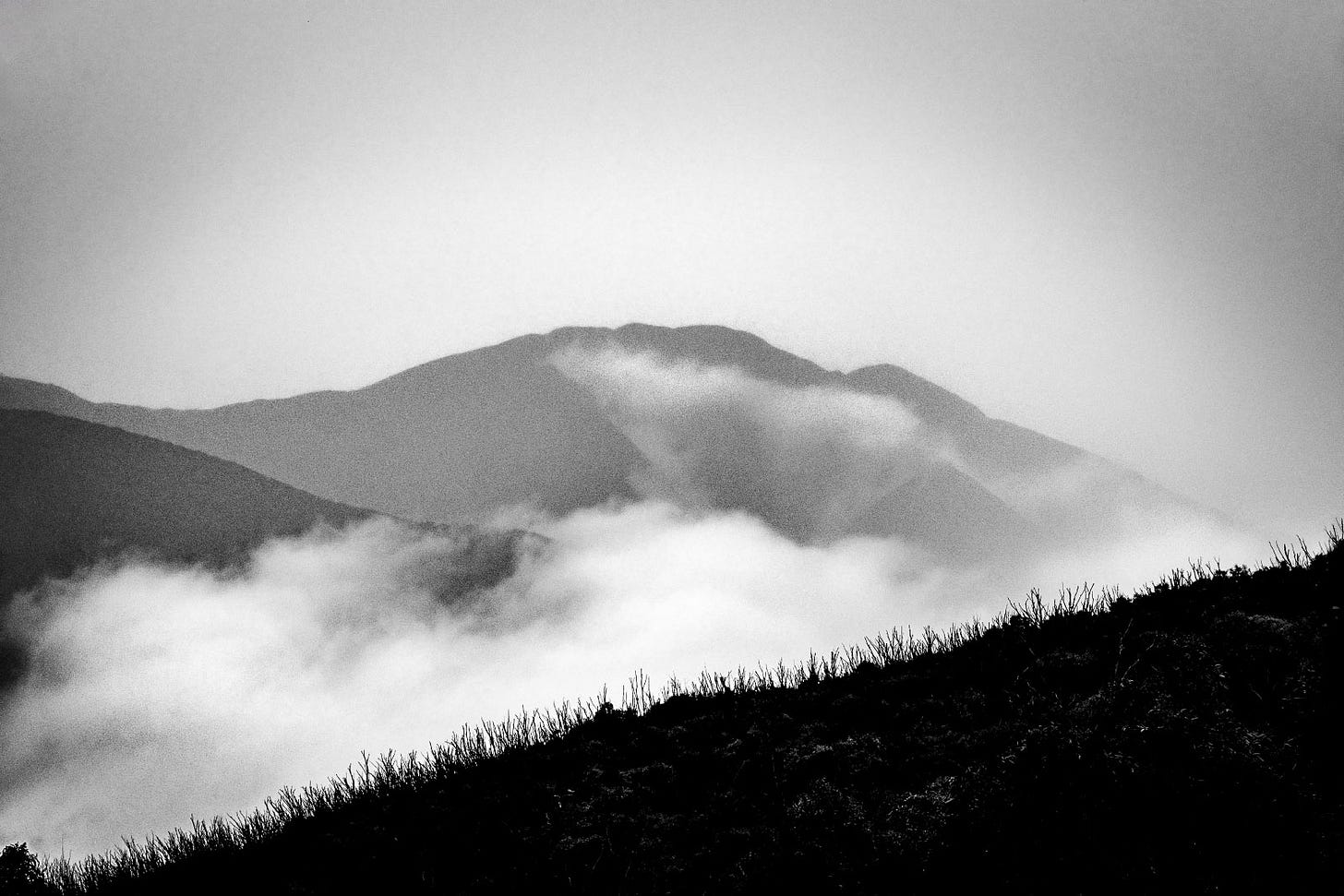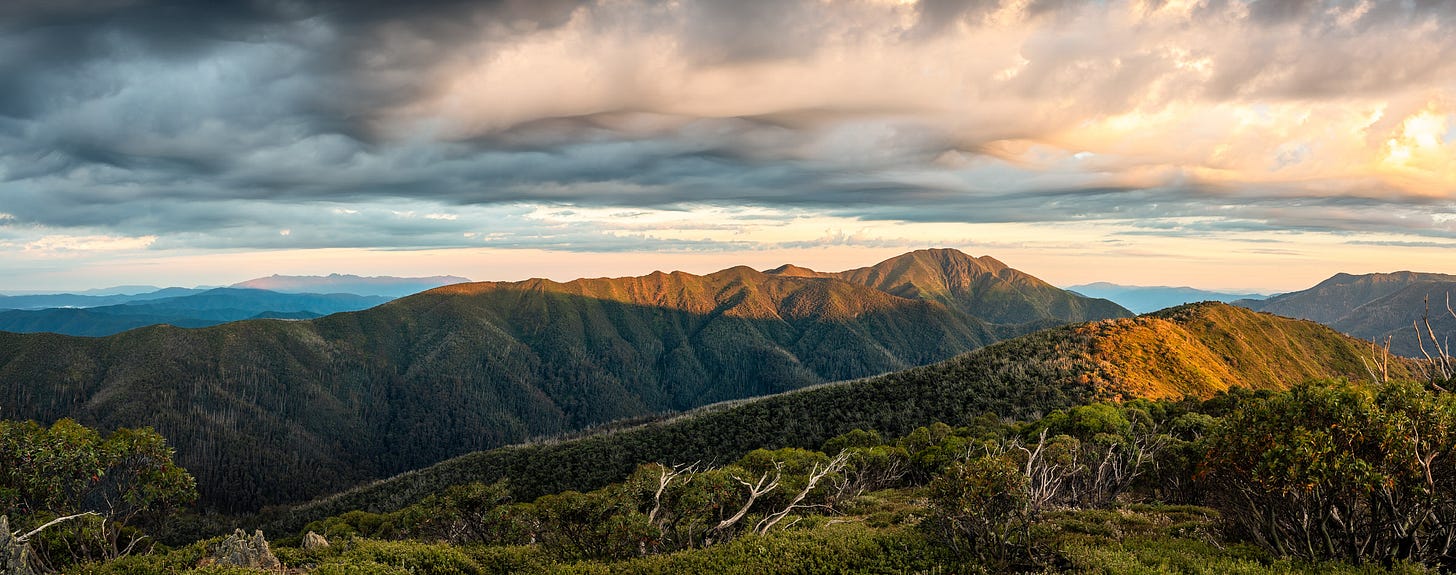After the Storm
Part 1 - Changing conditions make for dynamic images
I recently spent four days camping up in Victoria’s High Country with a particular focus on the area around Mount Feathertop, one of Victoria’s more iconic mountains. This is the first of two newsletters about this trip.
I. The Storm
Finally, I found a gap in the trees to reveal a view of Mount Feathertop where I could set up for a timelapse of sunset. The composition was okay, although I wondered if there may be a better vantage point further along the ridge. With plenty of time, I walked back up to the ridgeline and was hit by a fierce easterly wind. What had been a gentle breeze had changed direction and intensified as the predicted summer storms rolled across the mountains.
I could see lightning on the Bogong High Plains just across the deep valley of the Kiewa River and the storm was heading my way. Thoughts of finding a clearer view of Mount Feathertop were immediately forgotten as I grabbed my camera, tripod and rucksack and raced back up the exposed ridgeline towards camp.
As the storm front came closer, the thick storm clouds filled the valley below me. I stopped to snap a couple of images, but I did not want to be above the tree line with lightning around.
The day had started early with a long drive from Melbourne to the Mount Hotham ski resort. Then it was a beautiful but hot walk out along the Mount Loch ridge with the Bogong High Plains to the north-east and Mount Feathertop to the south-west, separated by steep valleys that can make for very challenging walking.
My plan for this trip, however, was to stay on the ridgelines and spend four days with a vague idea to take images, in various ways, of Mount Feathertop.
It had taken a little time to find the right spot, but eventually I had decided on a location to pitch my tent. By mid-afternoon, before I went to find more images, I had camp set up in a little saddle, below the tree line, which would provide some protection from the expected storms. I was very pleased I was well set up.
The rain started just as I reached my tent and I dived for cover. For the next half hour or so I was buffeted by strong winds and hail, followed by surround sound thunder as the storm seemed to pause directly overhead. All I could do was sit tight, watch the water pool around my tent and hope.
Around 5.30 pm, still three hours before sunset, there was a pause in the rain and so I headed out to take a look. In every direction the view was a dynamic, monochromatic landscape.
I stood on a rocky outcrop watching the clouds swirl through the valleys and up over the ridgelines. At times, I was completely surrounded by cloud, the Snow Gums ghostly shapes as my view was limited to my immediate surroundings. Then the clouds would open momentarily revealing the depth of the valleys that run between these narrow ridgelines.
I wanted to try and capture this dynamic scene despite the low light (I ended up at ISO 1000 to avoid camera movement in the windy conditions). The first image below is looking east, towards where the storms came from, with the Kiewa River somewhere in the valley below. The second image is looking west towards Feathertop and is the first image from the trip of the mountain that I liked. I had not envisaged an image of Mount Feathertop like this when I left Melbourne on a beautiful summer’s day some 12 hours earlier.
With only intermittent rain and lighter wind, I had some dinner and went to bed. Being exposed to the rawness of nature is exhilarating, but I was very pleased to be warm and dry. I slept soundly, hoping for some more benign conditions in the morning.
II. The Dawn
The alarm went off at 5am, about an hour before dawn. I did not have a composition planned after the challenges of last night – instead, I had decided I would head back up the ridge to a higher point above the tree line where there should be a good view of Mount Feathertop.
After about half an hour, I found my spot. Although there was heavy cloud cover, it looked clear on the eastern horizon and, while I wasn’t expecting a lot of sunrise colour, I was hoping the sun would slip under the clouds and light up the mountain.
With time (as usual) getting tight, I set up my second camera (Sony A6700 – relatively small and light) on my second tripod (an aluminium Monfrotto – big and heavy) for a timelapse. The light happened just as I hoped.
With the timelapse going, I was able to move around and explore other compositions with my main camera (Sony A7 iv) and lightweight tripod. While I need to monitor and adjust the timelapse exposure as the sun comes up, this set-up maximises the opportunities in the field. It does come at a cost – I am juggling a lot of things at once and there is a lot of gear to carry (that beast of a tripod is almost 2.8 kg).
My best image of the morning is the panorama below, showing off Mount Feathertop in all her glory. The pano consists of three landscape orientated images (1/20th sec at f9.0, ISO 125). There is a lot in this image. I love how the brightness of the ridgelines reduces with distance, and this is mirrored in the clouds.
To the right is the brightest ridgeline, the one I camped on the previous night, with Mount Fainter North and South with just a little light in the far distance. Then we have Mount Feathertop with the Razorback extending to the left (the ridgeline in front of Feathertop is where I will camp the second night). And in the distance is Mount Buffalo which is partially lit up with the shadow of Feathertop apparent on its side.
After the extreme weather of last night, it was a pleasure to wander around in the early morning sun with my camera exploring different compositions and techniques. Sometimes I know an image is unlikely to work but I just want to try something. Sometimes trying something can lead to another idea, which sparks another thought and then I will see something I hadn’t noticed initially.
Sometimes I will try moving around or just sitting still. I will change the aspect ratio on the EVF and LCD screen from 3:2 to square to pano and back again, or I try black and white. Perhaps some Intentional Camera Movement. I take some video. All these things help me see the landscape a little differently.
What do you do to try and find compositions that may not be immediately apparent? Share in the comments.
Before long I could feel the day starting to heat up and I knew I had a big day of hiking ahead of me. I walked back down the ridge to camp and had a leisurely breakfast as my wet tent hung over a dead Snow Gum branch to dry.
Looking forward to more adventures and photography opportunities, I was soon heading back along the ridgeline to the car to stock up on food and water and start my next walk along the Razorback.






Beautifully written and shot.
I love your sub header about capturing moments of change being a key to creating dynamic images. So true. I think as humans we are all drawn to change. In images, in storytelling etc. thanks for the reminder.
PS nice to find another Melbourne photographer here!
Stunning photographs James - especially love the b&w photos. That was quite a storm to be camped out in but what a beautiful part of the country, well worth suffering the weather for!